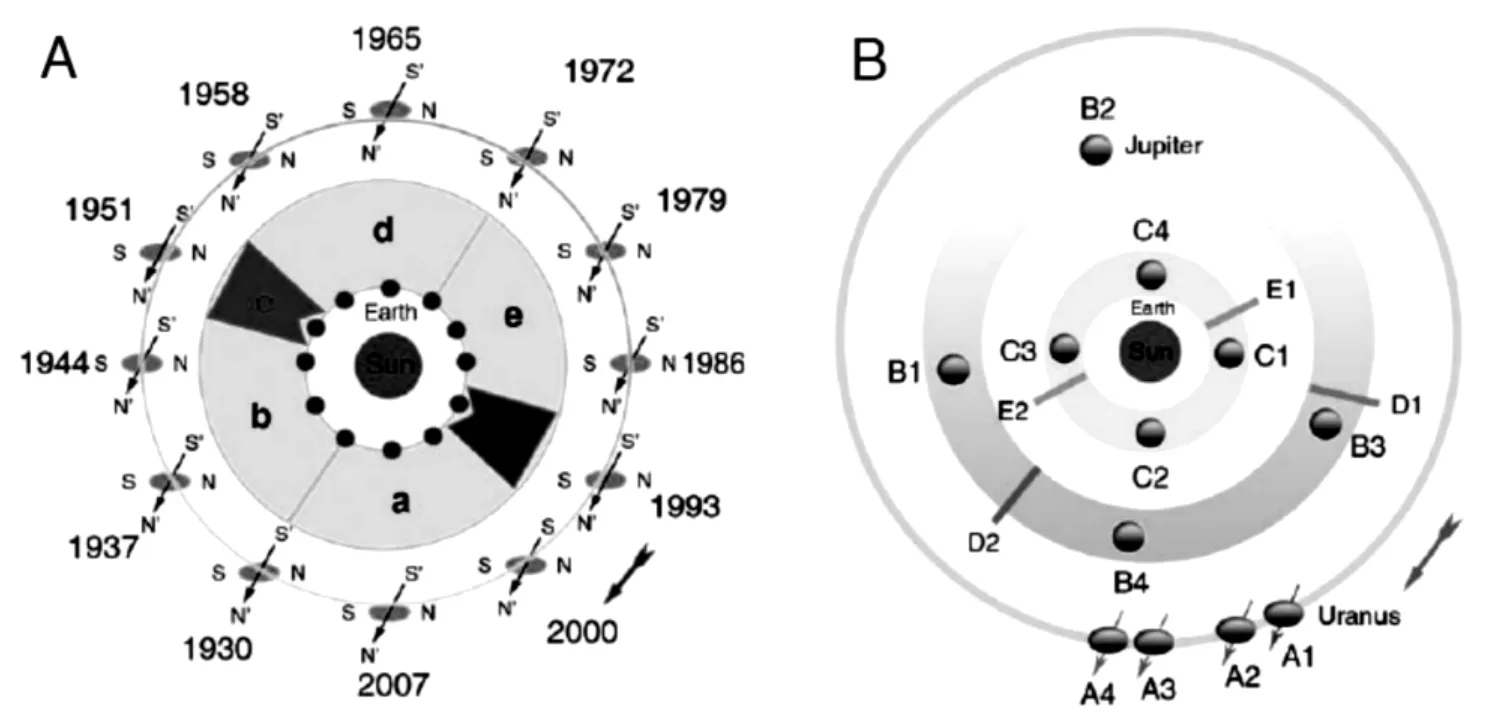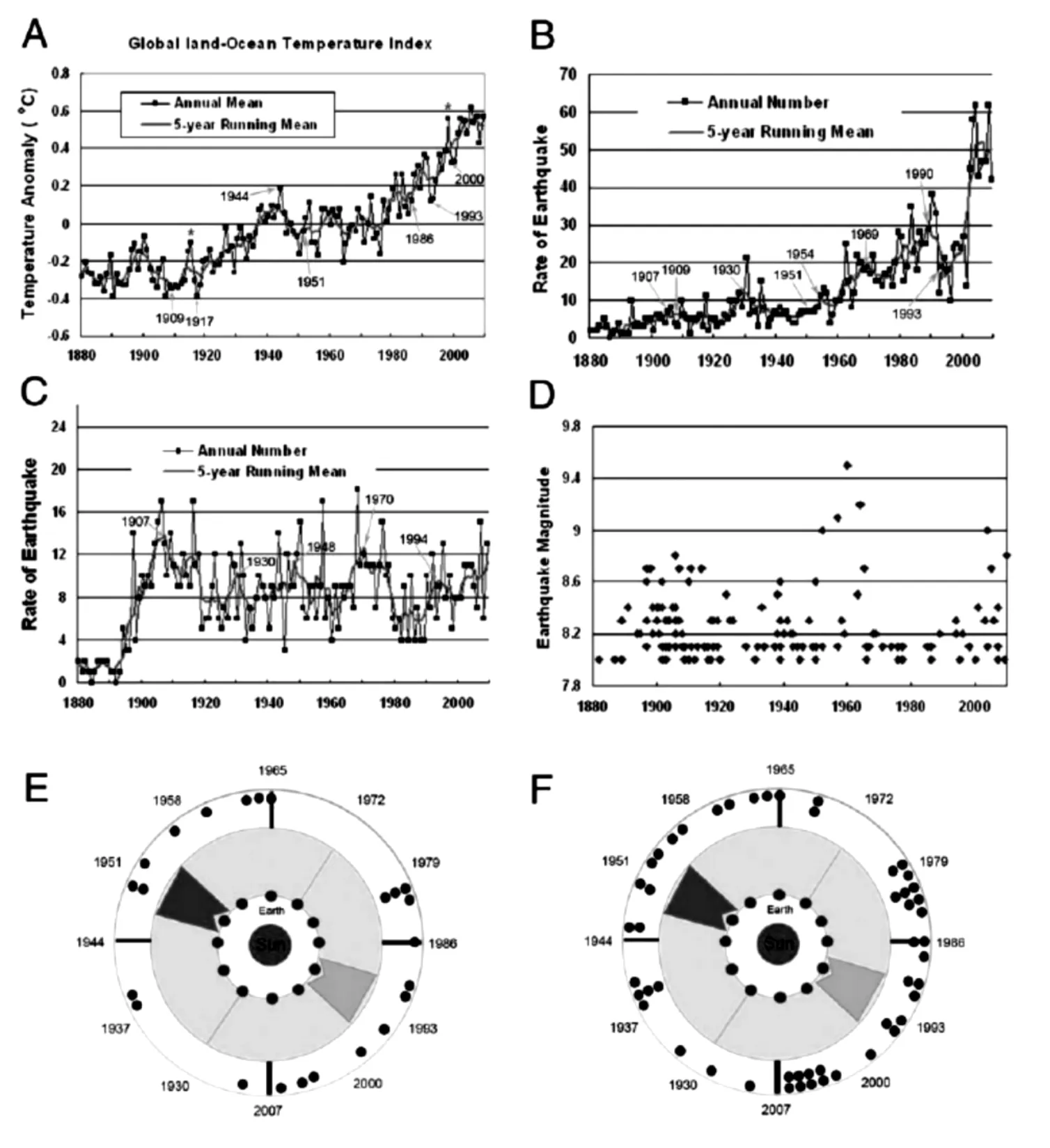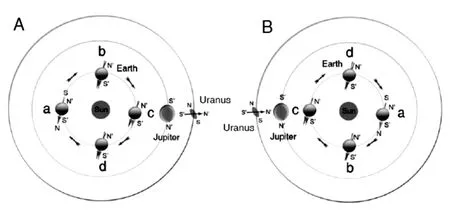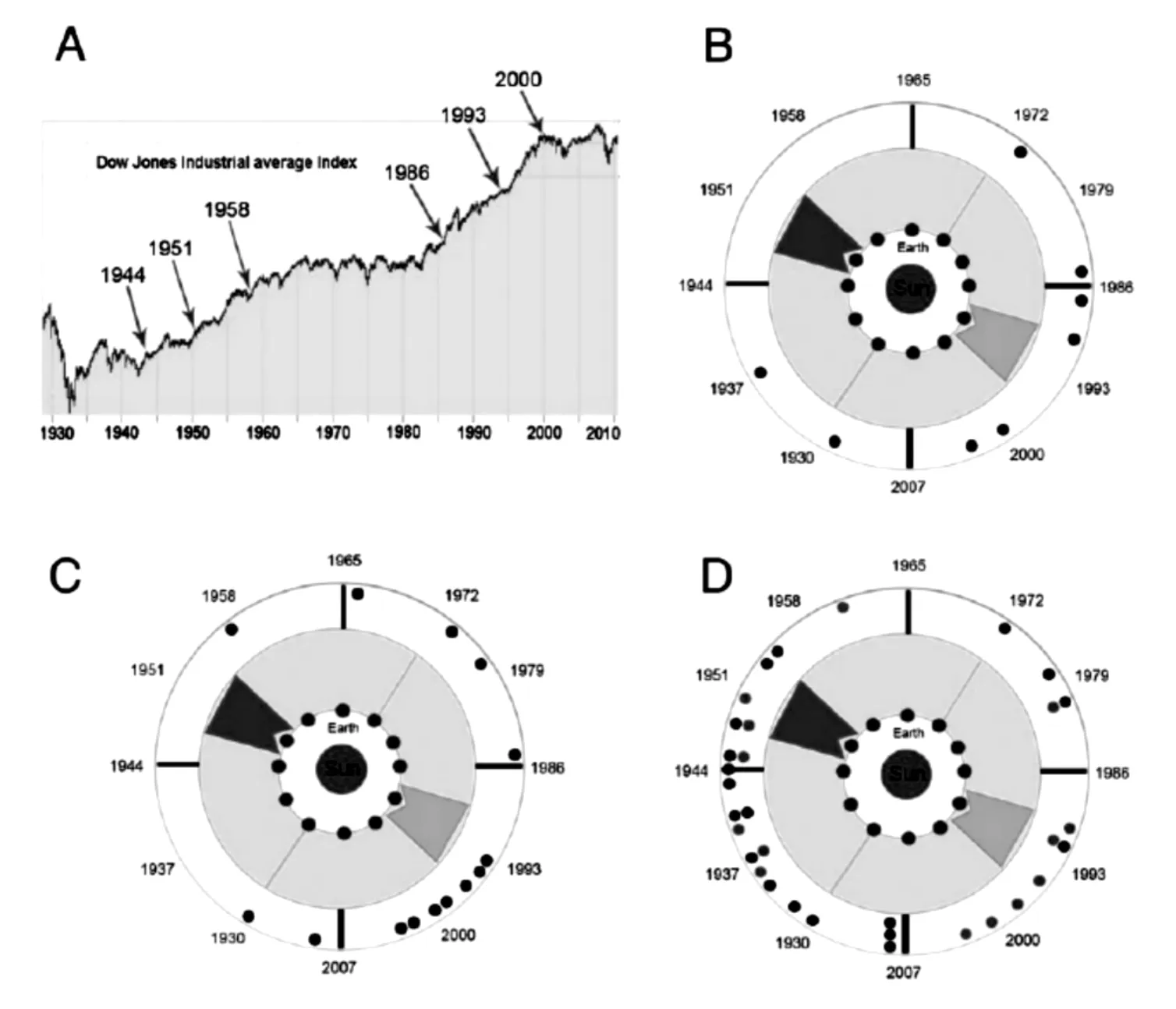The Revolution of Uranus Influences the Behaviors of Earth and Its Organism s
Dai Jiapei,Peng Liu
(Wuhan Institute for Neuroscience and Neuroengineering,South-Central University for Nationalities,Wuhan 430074,China)
Uranus is the seventh planet from the sun,and it is the third largest planet in the solar system.Uranus orbits the sun once every 84(84.01)earth years.During the past ten years,unexplained and abnormal changes in the behaviors of Earth and its organisms,including global warming,a high rate of earthquakes and natural disasters,a new prevalence of viruses and economic instability have perplexed us.It is not clear whether there is any relationship between the behavioral changes of Earth and its organisms and the movement of Uranus.Voyager 2 has found that the magnetic field of Uranus is tilted about60 degrees from the planet's axis of rotation and the dipole moment combined with the large spatial offset leads tominimum and maximum magnetic fields(0.1 and 1.1 gauss,respectively) on the surface of the planet of the southern hemisphere and the northern hemisphere[1,2].Here,we propose a model based on the revolution of Uranus and its unusualmagnetic field that presents the rhythmic change of the direction and intensity of the magnetic field as it faces the sun over an 84-year cycle(Fig.1A),which may rhythmically influence the behaviors of Earth and its organisms.
We first analyzed the global temperature trends from 1880 to 2008(Fig.2A)based on the NASA database (http://data.giss.nasa.gov/gistemp/graphs/).We found that the global temperatures present regular changes over an 84-year cycle,which can be divided into a 42-year period of gradual increase from 1909 to1951(1909 corresponds to 1993 in Fig.1A)and a 42-year period of relative stability from 1951 to 1993 corresponding to the periods during which the south and north magnetic poles of Uranus faced the sun,respectively(Fig.1A).An obvious increase in global temperatures during the years 1909-1944 is noticed before a rapid decrease during the years 1944-1951. In contrast, there are relatively stable global temperatures during the years 1951-1986 before a slow increase from 1986 to 1993.Although the records do not go back far enough to show global temperature trends over a 168-years period (two cycles),the pattern of global temperature trends from 1909 to 1917(corresponding to the period from 1993 to 2001 in Fig.1A)is quite similar to that from 1993 to 2000.Of these two periods the two hottest years were 1915 and 1998,respectively(an 83-years difference,asterisk in Fig.2A). These patterns indicate that 1993 was a repeat of 1909 in an 84-year cycle of global temperature trends.A similar pattern in global temperature trends can be seen in the periods 1800-1892 and 1963-1976,which reinforces our analysis.According to ourmodel,a further increase in global temperatures would be expected to continue for about 11 years(to 2021,corresponding to 1937 in Fig.1A) without considering factors such as the greenhouse gas effect[3]as it has been shown that the base level of global temperatures has increased about 0.2 degrees over the last century even if the rhythmic effects of an 84-year cycle are excluded(Fig.2A).

Fig.1 A diagram of the unusualmovement and magnetic field configuration of Uranus influencing the behaviors of Earth and its organisms via direct or indirect effects图1 图示天王星独特的运动和磁场布局通过直接或间接效应影响地球和地球上生物体的行为
To understand how the change of the direction of magnetic field of Uranus could influence global temperatures,we propose that the change of the direction and effective intensity of themagnetic field of Uranusmay result in an additional shiftof Earth's axial tilt to different degrees depending on the positions of Uranus and Earth during their revolutions(Fig.1B;Fig. 3A, B). These changing positions may rhythmically change the sun's illumination of Earth in addition to the well-known seasonal changes that are due to Earth's axis tilt(23.5 degrees).Such a proposal can be questioned by the fact that the magnetic field of Uranusmay not reach into the space where the Earth orbits[4].We propose the alternative possibility that Uranus may influence the Earth indirectly via Jupiter(Fig.1B,Fig.3A,B)because themagnetic field of Jupitermay reach into the part of space where Earth orbits and the magnetic field of Uranus can reach into the part of space where Jupiter orbits[4].Therefore,the effects could take place when Uranus,Jupiter and Earth move together into a space in which the Earth is effectively influenced by Uranus through the Jupiter(for example,from D1 to D1 and E1 to E2 for Jupiter and Earth,respectively,in Fig.1B).This analysismay provide an explanation for the year-to-year changes of global temperatures.An additional shift of Earth's axial tilt in this effective spacemay have resulted in increased temperatures in northern latitudes due to a greater amount of illumination from sunlight from summer to autumn in recent years(Fig.1B;Fig.3A,B).This effectmay be the reason for the abnormal change of global temperatures,particularly the occurrence of abnormally hot summers in these years in countries close to North Pole such as Norway,Finland,Russia and Canada.It should be emphasized that,although we consider the effect of Uranus on Earth the result of interactions between their magnetic fields,our model does not exclude other possibilities,such as interactions via unknown forces or energies.

Fig.2 Global temperature trends and rate of earthquakes in relation to Uranus'revolution图2 全球温度变化趋势和地震发生频率与天王星公转的关系
Next,we analyzed the rate of earthquakes occurring globally between 1880 and 2009(Fig.2B,S-Tab.1) based on the Significant Earthquake Database NGDC(http://www.ngdc.noaa.gov).We found a rhythmic change of small to moderate-sized earthquakes(4.5-6.9)over an 84-year cycle.Earth generally experienced a stable period for the occurrence of earthquakes from 1909 to 1951 (42 years),although a high rate of earthquakes can be seen around 1930.The rate of earthquakes increases gradually from 1951 to 1993 before a sharp decrease from 1992 to 1996.We analyzed the time trends for the rate of global earthquakes and found that a high rate of small to moderate-sized earthquakes(4.5-6.9)occurred around 1907,1930,1954,1969 and 1990(single arrow,Fig.2B,S-Tab.2).These dates are almost equivalent to periods around 1907,1930,1948,1970 and 1994(single arrow,Fig.2c)for the occurrence of a high rate of large-sized earthquakes with magnitudes greater than 7.0.The occurrence of a high rate of small to large earthquakes is highly related to the specific positions of Uranus'revolution,where the direction or intensity of themagnetic field of Uranus is just being transferred.We also investigated the time trends of very large earthquakes(≥8.0)from 1800 to 2009 and we noticed that the periods around 1930 and 1972,which had a high rate of small-to large-sized earthquakes, presented far fewer very large earthquakes(≥ 8.5)(Fig.2D,E,S-Tab.2).Therefore,we analyzed the data of very large earthquakes(≥8.5)during the past 1,140 years(from 869 to 2009,S-Tab.3).Interestingly,we found much lower rates of very large earthquakes in two corresponding periods(1924-1936 and 1966-1978,Fig.2F)if the year of earthquake occurrence before 1923 was transferred to the corresponding year(1924-2007) in an 84-year cycle,suggesting that the occurrence of very large earthquakes is related to the revolution of Uranus.Such a phenomenon may be useful for predicting very large earthquakes,which are much more dangerous to human beings.

Fig.3 A diagram of the shift of Earth's axial tilt affected by Uranus via indirect effects图3 图示天王星通过间接效应导致地球自转轴倾斜度的摆动
We then investigated whether the revolution of Uranus could affect the behaviors of human beings and other organisms.Because the stock market reflects colonial behaviors of human beings,we analyzed the trends of the US stock market(Dow Jones Industrial Average Index)from 1928 to the present(82 years)based on the database from the Yahoo(www.yahoo.com/finance, Fig. 4A). We found a regular fluctuation in the stock market over an 84-year cycle with a relatively stable period from 1951 to 1993(42 years)and two periods of instability from 1928 to 1951 and 1993 to the present(a total of 40 years).The period from 1993 to the present reflects a similar situation from 1909 to1926(not shown in Fig.4A),which was indeed an unstable market(four stock market crashes,Tab.1),indicating that the year 1993 marked the beginning of a new 84-year cycle following the previous one from 1909 to 1993.The change of the direction and intensity of the magnetic field of Uranus is reflected in the change of stock market trends.For example,the trends of the US stock market from 1944 to 1958 resembles that of1986 to 2000,corresponding to the two transitional periodswhen the direction of the magnetic field of Uranus facing the sun changed from south to north(1944-1958)and north to south(1986-2000).We analyzed the instances of US stock market crashes from 1901 to 1987 and found thatmost of the stock market crashes tended to occur during the transitional period when Uranus changed the direction of itsmagnetic pole toward the sun from north to south(1985,1990,2000,2003)or the two periods when the direction of the magnetic pole of Uranus faced the sun at about90 degrees(1929 and 1972)(Fig.4B,Tab.1).
Next,we analyzed the prevalence of influenza(flu),which has seriously affected human beings.During the past300 years,the prevalence of severe flu outbreaks mostly tended to occur during the specific period when the sunward direction of Uranus'magnetic pole transitioned from north to south(Fig.4C,Tab.1),indicating that the prevalence of serious flu viruses occurs over an approximately 84-year cycle.For example,the Russian flu appeared in 1887(corresponding to 1972 in the last century),and a similar outbreak occurred in 1977,which is just a 3-year difference in an 84-year cycle(Fig.4C,Tab.1).
Finally,we analyzed whether the important wars and social instabilities that human beings have instigated throughout history are also related to the revolution of Uranus.We noted the key events from the past422 years(1588 to the present,about5 cycles of Uranus'revolution,Tab.2)and found thatmost of the important wars or social instabilities seemed to occur most intensely during the periods when the southern magnetic pole of Uranus faces the sun,particularly in the periods corresponding to 1930 to 1951(Fig.4D).

Fig.4 US stock market trends and crashes,prevalence of flu(including SARS virus),and wars in relation to Uranus'revolution图4 美国股市的走势和崩盘、流感(包括沙氏病毒)的流行和战争与天王星的公转有关
The reasonswhy the wars,social instabilities and stock market crashes instigated by human beings are related to the revolution of Uranus are not clear.Our analysis indicates that the change of direction and effective intensity of themagnetic fields of Uranus over an 84-year cycle might play an important role,although other factors should also be considered.The effects of magnetic forces on human behaviour have long been noted.For example,patients suffering from depression have been known to improve their symptoms after exposure to magnetic fields[5]. Whether the rhythmic changes of the orientation of the magnetic field of Uranus leads to changes in human psychological states or moods, such as anxiety,excitement and depression,which could contribute to war-making and economic and social instabilities,needs to be investigated further.Some evidence indicates that such a psychological effect may be possible.For example,in both Western Europe and the United States therewas a three-to fourfold increase in rates of depression between the 1937-1946 birth cohort and the 1947-1956 birth cohort[6].
Human beings face many challenges,not only from our environments,but also from ourselves.Our analysis here indicates that the behaviors of Earth and its organisms are affected rhythmically by other planets such as Uranus.As a prediction based on our model,it seems that we may pass over the prevalence of flu viruses such as H1N1 for the time being.However,we aremarching towards a period of risk,in which wemay face further increases in global temperatures,serious natural disasters,economic and social instabilities and even big wars.
To get supplementary Table 1-3(S-Tab.1,2,3),please E-mail to:jiapeidai@msn.com.

表1 美国从1901-1987年美国股市崩盘和1510至今全球严重的流感流行时间分布Tab 1 Time distribution of US stock mark crisis(1901-1987)and global severe flu outbreaks(1510-present)

表2 1588-2003年全球重要战争时间分布Tab 2 Time distribution of global importantwars(1588-2003)
[1]Ness N F,Acuna M H,Behannon KW,et al.Magnetic Fields at Uranus[J].Science,1986,233:85-89.
[2]Sabine S,Jeremy B.Convective-region geometry as the cause of Uranus'and Neptune's unusual magnetic fields[J].Nature,2004,428:151-153.
[3]Hansen J,Sato M,Ruedy R,et al.Globalwarming in the twenty-first century:an alternative scenario[J].Proc Natl Acad Sci USA,2000,97:9875-9880.
[4]Cowley SW H,Bunce E J.Origin of themain auroral oval in Jupiter's coupled magnetosphereionosphere system[J].Planet Space Sci,2001,49:1067–1088.
[5]Pascual-Leone A,Rubio B,PallardóFM.et al.Rapidrate transcranial magnetic stimulation of left dorsolateral prefrontal cortex in drug-resistant depression[J].Lancet,1996,348:233-237.
[6]Klerman C L.,Weissman M M.Increasing rates of depression[J].JAm Med Assoc,1989,261:2229-2235.

